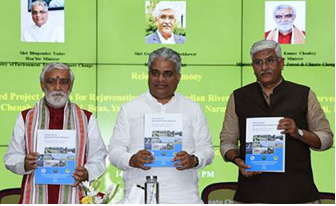River Rejuvenation through Forestry Interventions: MoEF&CC releases DPRs for 13 Rivers
- 15 Mar 2022
On 14th March, 2022, the Union Ministry of Environment, Forest and Climate Change (MoEF&CC) released the Detailed Project Reports (DPRs) on rejuvenation of thirteen major rivers through forestry interventions.

- The 13 rivers for which DPRs were released are Jhelum, Chenab, Ravi, Beas, Sutlej, Yamuna, Brahmaputra, Luni, Narmada, Godavari, Mahanadi, Krishna, and Cauvery.
- The DPRs were funded by National Afforestation & Eco-development Board, (MoEF&CC) and prepared by Indian Council of Forestry Research & Education (ICFRE), Dehradun.
- These thirteen rivers collectively cover a total basin area of 18,90,110 sq. km that represents 57.45% of the geographical area of the country. The length of 13 rivers including 202 tributaries within the delineated riverscapes is 42,830 km.
- These DPRs will create a target of green cover expansion for upcoming 10 years and 20 years, then the future generations will get a ‘Green India’ through the ‘Van Bhagidari and Jan Bhagidari’ of the current generation.
- The projects will alleviate the growing water stress and help achieve national goals related to climate change and sustainable development.
Need
- Growing water crisis on account of depleting fresh water resources, especially due to shrinking and degradation of river ecosystems is a major impediment to achieving national goals pertaining to environment, conservation, climate change and sustainable development.
Focus of the DPRs
- The DPRs focus on protection, afforestation, catchment treatment, ecological restoration, moisture conservation, livelihood improvement, income generation, and ecotourism by developing river fronts, eco-parks and bringing awareness amongst the masses. Research and monitoring have also been included as a component.
Executing Body & Funding
- The DPRs are expected to be executed through the State Forest Departments as nodal department and with convergence of schemes of other line departments in the states towards the activities proposed in the DPRs and funding support from the Government of India.
About the Project
- Landscape Approach: The rivers along with their tributaries are proposed for forestry interventions in the riverscape under different landscapes namely natural landscape, agricultural landscape and urban landscape.
- Models of Forestry: The different models of forestry plantations including timber species, medicinal plants, grasses, shrubs and fuel fodder and fruit trees are aimed to augment water, ground water recharge and contain erosion.
- Site-specific Treatment: In terms of soil & moisture conservation and plantations of grasses, herbs, forestry and horticultural trees have been proposed for treatment of prioritized sites in the riverscape supported by GIS technique.
- During execution, “Ridge to Valley approach” shall be followed and soil & moisture conservation works would precede the plantation operations.
Benefits
- The activities proposed in the DPRs shall help achieve potential benefits of increasing the green cover, contain soil erosion, recharge water table and sequester carbon dioxide in addition to benefits in the form of non-timber forest produce.
- NDC Commitment: These efforts will play an important role achieving the international commitments of India such as NDC forestry sector goal of creation of additional carbon sink of 2.5 -3 billion tons of CO2 equivalent through additional forest and tree cover by 2030 under the Paris Agreement of UNFCCC, restoration of 26 million hectares of degraded lands by 2030 as a land degradation neutrality target under UNCCD, halt the biodiversity loss by 2030 under CBD and Sustainable Development Goals (SDGs).
- Panchamrit Commitment: It will strengthen the country’s progress towards Panchamrit commitment at CoP-26 during November 2021 in Glasgow whereby India promised to reduce its projected carbon emission by one billion tonnes by 2030, meet 50 per cent of energy requirements with renewable energy by 2030, enhance non-fossil energy capacity to 500 gigawatt by 2030, reduce the carbon intensity of its economy by 45 per cent by 2030 and achieve net zero emission by 2070.
Conclusion: Aviral Dhara, Nirmal Dhara besides Swachchh Kinara
Timely and effective implementation of the proposed forestry interventions as envisaged in DPRs of 13 major Indian Rivers is expected to significantly contribute towards improvement of terrestrial and aquatic biota, and livelihoods besides rejuvenation of the rivers in terms of Aviral Dhara, Nirmal Dhara besides Swachchh Kinara.




